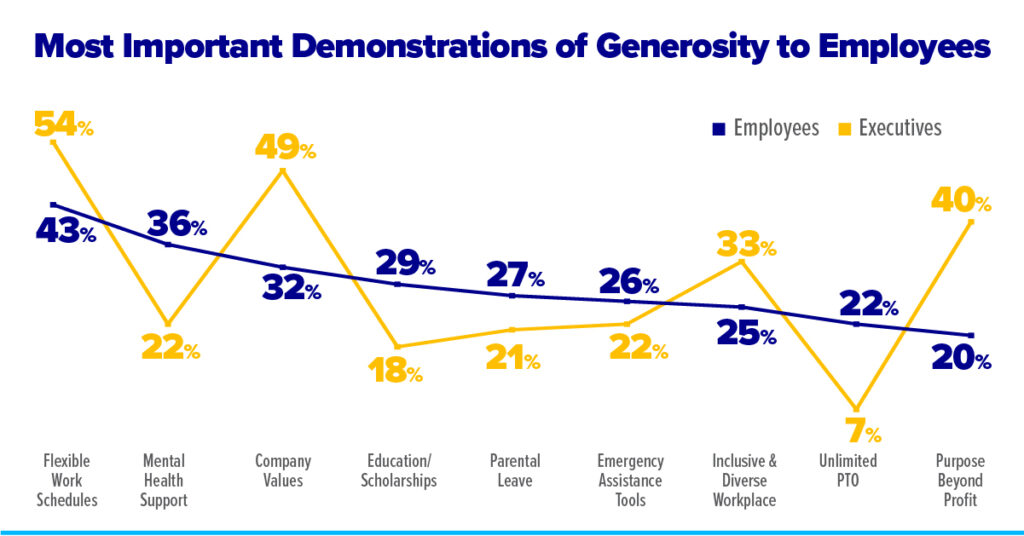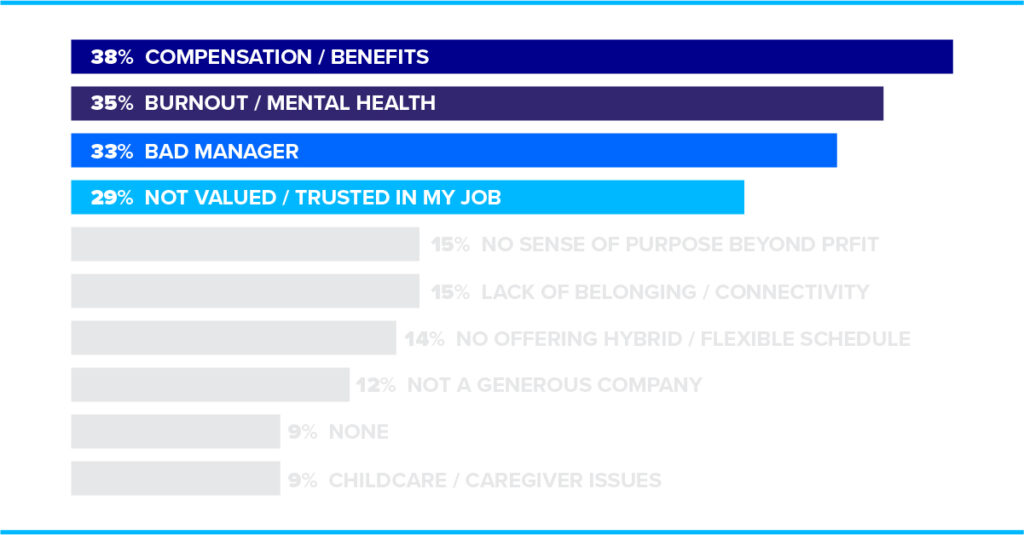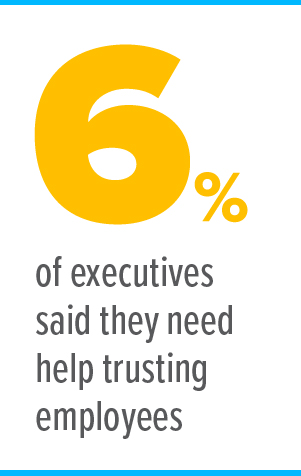Chapter Two:
Prioritizing Employee-Centric Generosity
How to prioritize generosity efforts
Survey respondents were given a list and asked in what order a generous company should prioritize taking care of their stakeholders. The responses came back with resounding alignment – focus on employees. 85% of executives and 82% of employees chose employees as either their #1 or #2 choice with the vast majority placing employees at #1.
Subsequently, executives selected customers 74% of the time landing them in second place, with shareholders at a mere 17% in a distant third. Similarly, employees also selected customers 60% but placed community as their distant third 24%.

Executives recognize generosity’s role in company culture. 88% agree that generosity helps create a connected, engaged culture and 83% believe that generosity helps them attract and retain talent. However, the data shows they may not be aware of what employees consider the most effective ways to demonstrate their generosity.
In fact, 1 in 3 employees graded their employer a C, D or F in the ways they currently demonstrate generosity to employees. There’s a substantial opportunity to improve this perceived gap with specific, concrete actions that better align with employee desires.
What exactly do employees want?
In an open-ended question, we asked employed adults to name specifically what a company does that shows them it’s truly generous. 63% of the responses focused on specific programs and offerings for the employee work experience including compensation. Only 31% of their responses mentioned traditional definitions of generosity such as charitable giving to the community and volunteerism. This reinforces the guidance that right now, the top priority for demonstrating generosity at your company is to improve generosity towards employees.

To dig deeper into specific tactics, respondents were given a list of concrete ways that a company can demonstrate generosity inside their business. Executives and employees alike both selected flexible work schedules as the top choice.
Executive respondents aligned around three priorities, naming flexible work schedules as #1 (54%) closely followed by statements describing company culture such as company values (49%) or a purpose beyond profit (40%). Executives’ fourth pick for demonstrating generosity to employees was an inclusive and diverse workplace (33%).
While employed adults also selected flexible work as their top choice for demonstrating generosity to employees (43%), they quickly converged around specific employee care benefits. Mental health support (36%) was their second choice, but it is valuable to notice the tight race between employee education/scholarship assistance (29%), parental leave (27%), emergency assistance tools (26%), and an inclusive and diverse workplace (25%) all in a near tie for fourth. Of note, employees of color were statistically more likely to place employee education or scholarship assistance in their top 3 (34% vs 24%).
It is clear that an important misalignment exists when it comes to specifics on “how to” demonstrate generosity toward employees. While executives elevated company culture statements as proof of their generosity to employees, with 40% of executives naming “purpose beyond profit” in their top three, employees focused on specific actions, with “purpose beyond profit” ranking at the very bottom of the list. Chapter Three outlines the power of company culture statements to drive connectivity but when it comes to showing employees you care, tangible actions are the priority.
WARNING: Mental health support plays a major role in why employees are leaving AND what will help them stay
Throughout the survey, respondents continually elevated mental health among a wide range of options. We asked the most influential reasons for why they would leave their employer and gave them the opportunity to select up to three choices. The answers tell a compelling and concerning story. While executives deal with the reality of a talent shortage and compensation battle, paying closer attention to the role of mental health may actually be the key to keeping and attracting talent.
38% of employee respondents chose compensation as an influential reason for leaving, followed quickly by 35% who selected mental health. Interestingly, other factors that contribute to poor mental health (i.e. bad manager and not feeling valued or trusted in their job) followed closely behind.
What is influencing employees to leave their company?

When given nine options for how an employer can demonstrate generosity to employees, a flexible work schedule was the top choice but mental health support (36%) was the resounding number two. Employees who worked remotely are even more likely to say that mental health support (44% vs 31%) is a way that executives can show generosity to employees.

As executives consider the makeup of their workforce, mental health support is 20 percentage points more important to employees under 35 and 10 percentage points more important to women as an important way to demonstrate generosity.
A word of caution, when given the exact same options to choose from, mental health support did not show up in executives top four choices for how best to demonstrate generosity toward employees.
Employees want to be trusted. Executives may not be aware that there’s room for improvement

When asked specifically what their chief executive can do to demonstrate generosity, employees name listening (53%) and trust (44%) as their top choices. Interestingly, while executives and employees agree that listening is the #1 way that a leader can demonstrate generosity, there’s a disconnect for executives on the importance of trust. Executives ranked trusting employees as their fourth choice for how to display generosity behind listening, transparency, and empathy. When asked in a later question whether they need help demonstrating that they trust employees, again there was a disconnect as very few executives named trust as a concern (6%).
When you look at this data holistically, the many warning signs surrounding your employee’s mental health paint a concerning picture. From feelings of burn out to bad managers who make them feel undervalued or distrusted, employees are sending a clear message that they need help. Inspiring purpose statements and grounding company values do not meet deep personal needs. If executives focus entirely on employee’s top request – compensation – without tuning into these underlying health and wellness issues, turnover will likely continue.
Explore further insights:
In Partnership with





